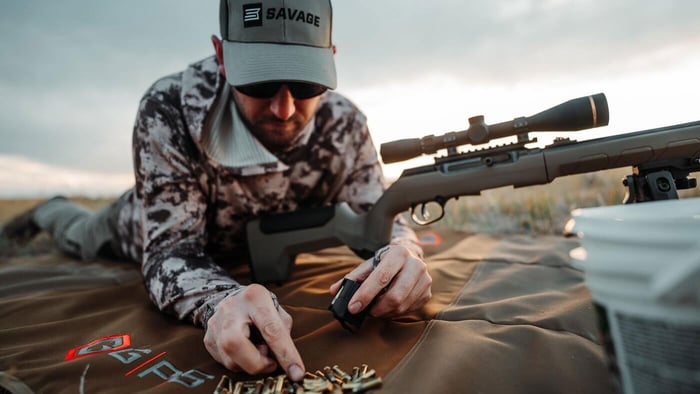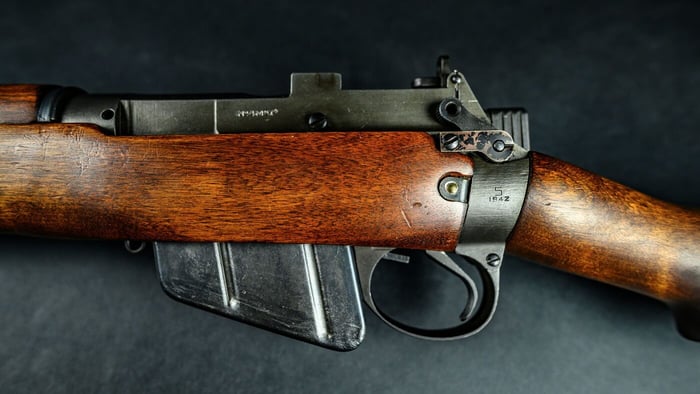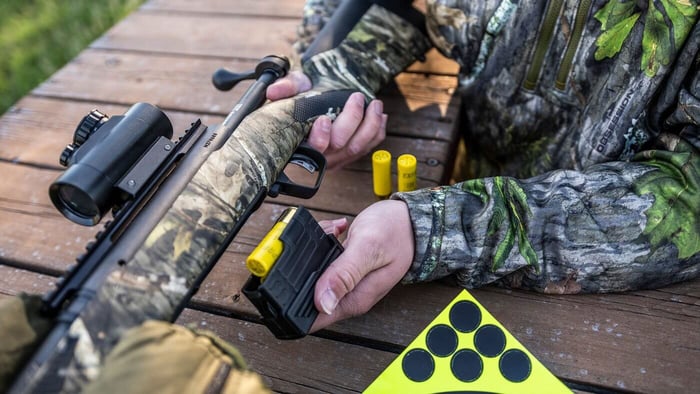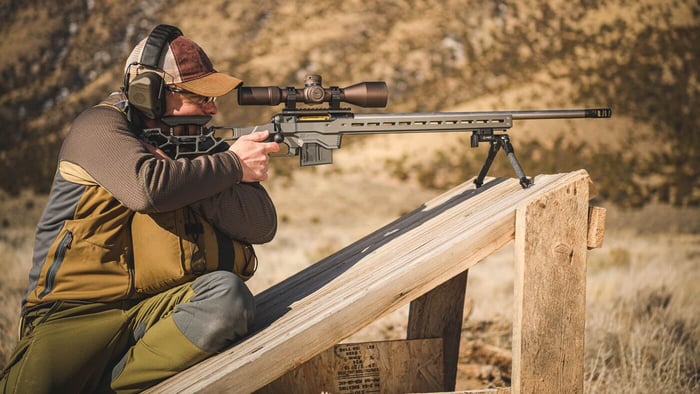- Savage Blog
- Polymer vs. Metal Magazines: Which is Best for Your Rifle?

It’s an age-old debate in the firearms community, the battle of polymer vs. metal magazines. As technology and materials continue to evolve, so do the preferences and performance expectations of shooters. The type of magazine you choose hinges on factors such as weight, reliability, availability, and what you’re using each firearm for.
But which one is better for your needs—polymer or metal? Let’s break down the history, benefits, drawbacks, and specific use cases for both to help you make an informed choice.
Detachable Box Magazine History
First Detachable Box Magazines
The detachable box magazine has a long history. Originally developed in the late 19th century, early military rifles like the Lee-Metford and Lee-Enfield were among the first to feature removable box magazines. Arthur Savage also developed an early detachable box magazine patent for the Savage Model 1899 in 1908, although it would take several decades before Savage firearms commonly featured these types of magazines.
Widespread Use and Adoption
After World War II, detachable magazines became standard on many military rifles and continued to make their way into civilian firearms. Metal magazines were the standard for decades on many rifles. However, as manufacturers began to explore alternative materials to improve performance and reduce weight, this ultimately led to the development of high-strength polymer magazines that are in common use today.

Metal Magazines
Today’s metal magazines are often made of steel and aluminum, and are commonly used in both rifles and handguns. Many metal magazines today will come with polymer or rubber baseplates, especially those that are meant to be flush fit with a rifle stock or handgun grip.
Benefits
Durability: Metal magazines can take a beating when it comes to damage, and are chosen by some individuals who are looking for a high level of durability and reliability.
Heat Resistance: Metal handles high temperatures better, which can be beneficial during extended shooting sessions or long days on the range in the sun.
Structural Integrity: Metal mags are less likely to swell or warp, especially in extreme cold or heat.
Drawbacks
Weight: Metal magazines, especially steel magazines, are generally heavier, which can impact mobility for competitions or backcountry hunts. If you’re worried about saving weight, consider an aluminum magazine for less weight compared to steel.
Corrosion: Without proper treatment or maintenance, metal magazines can rust over time. To combat this, some manufacturers will use powder coating or aluminum alloys to help prevent rust and corrosion.
Cost: Depending on the firearm, steel and aluminum magazines can be more expensive due to higher material and production costs. There are also not always as many aftermarket options when compared to polymer magazines.
Common Uses
Metal magazines are widely used in most hunting and shooting applications. They are often used for flush-fit magazines and are preferred by many in situations where reliability and ruggedness are key factors. Several Savage firearms utilize metal magazines, including the Axis, Model 110, Mark II, Stance XR, and 1911.

Polymer Magazines
Benefits
Lightweight: Polymer construction significantly reduces weight, making your rifle easier to carry, especially during long backcountry hunts or times when you are carrying multiple magazines..
Corrosion-Resistant: Unlike metal, polymer doesn’t rust or corrode, which is a plus in wet or humid environments. Polymer magazines don’t require being carefully maintained like a metal magazine may need to be.
Cost-Effective: Easier to produce at scale, polymer magazines are often more affordable for most firearms.
Design Flexibility: Polymer allows for innovative features like textured grips, see-through windows, and integrated followers. This allows for a wide range of aftermarket options for polymer magazines.
Drawbacks
Impact Sensitivity: While modern polymers are durable, they may crack or chip if they are repeatedly dropped on hard surfaces. This is especially prevalent on the feeding lips near the top of the magazine, but can be prevented if the magazine incorporates steel feeding lips. These magazines being lighter also means they may need to be pulled from your firearm, rather than being dropped free when released.
Heat Deformation: Under extreme heat (like rapid firing or intense environmental heat), polymer can soften or warp slightly. This will impact not only durability but also feeding reliability.
Fit Variability: Polymer molds can sometimes lead to inconsistencies in mag-to-mag fit, particularly with aftermarket brands. Feeding lips on some polymer magazines may not work in some firearms, so checking for proper fit and function is a must.
Common Uses
Polymer magazines dominate the market for modern sporting rifles, but they're also popular in hunting, target shooting, and 3-gun competitions thanks to their balance of durability and weight savings. Many handguns also use polymer magazines for interchangeability and compatibility. You can find several Savage firearms with polymer magazines, including the A and B Series rimfire rifles, the 212/220 Slug shotguns, the Model 334 rifle, and select Model 110 rifles with AICS pattern magazines.

The Best Magazine for You
Choosing between polymer vs. metal magazines largely depends on how you plan to use your firearm and what features you value most.
Hunting
For most hunting scenarios, polymer magazines are a great choice:
They're lighter, reducing fatigue during long treks.
Polymer resists corrosion in wet, muddy, or snowy environments.
Many polymer mags have low-profile designs that are easier to carry in the field.
That said, hunters in extremely hot or cold conditions may prefer metal magazines for better performance in sub-zero temperatures. Metal magazines that are flush fit and contained within a firearm are also excellent for use during hunting.

Competition Shooting
In competition, reliability and rapid mag changes matter, but choosing between polymer vs metal magazines can be a tough choice.
Polymer magazines are often favored for speed and weight.
However, metal magazines offer better heat resistance and a rigid structure, especially important in long-range precision matches. Metal magazines also drop free more easily, which can help with magazine changes in a pinch.
Shooters who compete in PRS or tactical rifle disciplines often favor steel mags for their exact fit and consistent feed angle.

Compatibility and Availability
When you're choosing between polymer vs. metal magazines, always verify your rifle’s compatibility, especially when purchasing additional or aftermarket magazines. This will ensure that you have the best fit and reliability.
Some Savage rifles are specifically designed around proprietary magazines. Axis, Model 110, and Impulse rifles that use flush-fit magazines are proprietary and not compatible with aftermarket magazines.
Select Impulse and Model 110 rifles can use AICS pattern magazines and are compatible with aftermarket magazines in the same pattern.
Magazine availability for polymer vs. metal magazines may vary depending on the caliber or rifle platform you are shooting.
Personal Preference
Ultimately, your comfort and confidence in your gear matter most when choosing between polymer vs. metal magazines. Some shooters love the tactile feel and classic look of metal mags, while others prefer the modularity and innovation of polymer. It often comes down to:
Which magazine you're used to and have confidence in.
How much gear weight you’re willing to carry on longer hunts and hikes.
Your expectations for performance in the field or on the range

When weighing polymer vs. metal magazines, there’s no single winner—only what’s best for your unique application. Polymer excels in lightweight and cost-effective versatility, while metal shines in rugged, high-demand environments.
No matter which magazine you choose, know that nearly all magazines today are reliable, readily available, and come with various options. So, no matter which direction you choose to go in, you can have confidence in your equipment to get the job done.

